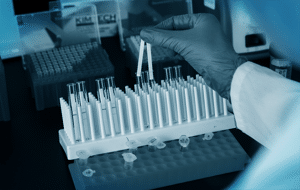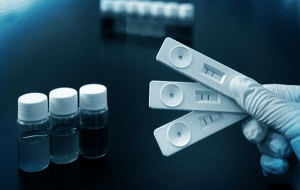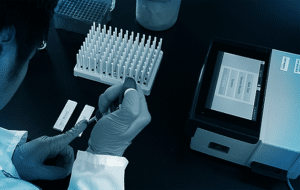>
>
>
Beyond Pregnancy Tests: Current Applications of Point of Care Diagnostic Testing
Beyond Pregnancy Tests: Current Applications of Point of Care Diagnostic Testing
- By George Parsons, Ph.D.
- February 14, 2018

Although a medic with a bag of simple medical supplies is not a fully equipped emergency room, he or she is the right solution for a wounded soldier on the battlefield. Medics can supply information and treatment that can enable that soldier to survive long enough to get more advanced medical treatment.
Similarly, the lateral flow assay (LFA) is the right solution for many point of care diagnostic testing applications not appropriate for a central laboratory. Because LFAs do not require electricity, running water or users with years of training, they can provide analytical information on the spot to inform decisions cost-effectively.
LFAs have advanced from their earlier versions both in terms of detection limits and areas of application. Here, we trace the history of LFAs and provide four examples of their modern applications in point of care diagnostic testing.
The Humble Beginnings of Immunoassay Development
In 1977, the Nobel Prize for Physiology or Medicine was awarded to Rosalyn Yalow and Solomon Berson for a discovery that they had made in 1959. They were the first practitioners of a then-new technique they called radioimmunoassay. An astounding array of applications have followed, allowing the detection and quantitation of substances of interest in a wide variety of disciplines and settings.
Clinical diagnostics has received the most attention, and the intervening years have seen the development of large automated instruments with impressive menus of assays. The radioisotopes in Yalow and Berson’s assay have been replaced with chemiluminescent and other non-isotopic marker molecules, and separations are now done with micron sized superparamagnetic particles. These instruments can produce hundreds of results an hour in random access using samples of serum or plasma from primary blood drawing tubes. On-board reagents for as many as 30 different assays can be loaded on the instrument.
The automated systems work well in a central laboratory setting, such as a hospital or a reference laboratory, but they are not appropriate in all situations where an analytical result is needed. For example, these instruments are often the size of two washing machines side by side. While most of these instruments are acquired as reagent rental units, high sample throughput is necessary to make placement economically viable for both the user and the instrument supplier.
Lateral flow technology helps fill the gap between central laboratory testing and use in point of care diagnostic testing. Modern lateral flow tests enable high sensitivity and multiplexing, and can clearly detect the presence of a wide range of biomarkers, pathogens, and environmental contaminants. Importantly, lateral flow assays can be deployed in a wide variety of industries.
Lateral Flow as Rapid Point-of-Care Diagnostic Testing for EMTs
Every year about 790,000 people have a heart attack and 114,000 die as a result. Rapid diagnosis is a critical first step in effective treatment of this condition. Zhu and colleagues have prototyped an LFA for point of care diagnostic testing that can detect relevant levels of Troponin I and Myoglobin in serum in an assay that takes only 15 minutes. Troponin has been called the “dying scream of cardiac tissue” and is released from heart cells when they die from lack of oxygen immediately after a heart attack. Myoglobin is also released from dying muscle tissue faster than Troponin, but it is not cardiac specific. Taken together, the two markers in an LFA can provide rapid and accurate, potentially life-saving diagnostic information even before the patient can be evacuated to a hospital.
Lateral Flow and Infectious Disease Point of Care Diagnostic Testing
Cruise ships allow busy people to sail away from their usual lives. However, sometimes non-human passengers embark on these ships, also. One such fellow traveler that makes the news every few months is Norovirus. This organism causes severe gastroenteritis with a wide range of unpleasant symptoms that can be easily confused with bacterial food poisoning. Effective treatment and prevention of food poisoning and Norovirus infection are quite different. The challenge in a very resource limited setting such as a cruise ship is how to tell them apart. R-Biopharm in Darmstadt, Germany has developed an LFA for point of care diagnostic testing that can detect the antigens shed by Norovirus in stool samples from sufferers. The assay can be run in 15 minutes and is claimed to have an accuracy of 96%.
Lateral Flow for Next-Generation Fertility Testing
Probably the most familiar application of the LFA is the home pregnancy test. Someday, there may be a home test also based on the LFA technology that will allow a woman to determine how much time she has left to become a mother. Viable ova develop from primordial follicles in the ovary. At birth, a baby girl has about one million such follicles. In adolescence, that number falls to about 400,000. At menopause, she may have only a thousand. The chronological ages at which these milestones occur varies from individual to individual. A good biomarker in blood for the number of primordial follicles is anti-Mullerian Hormone, and US Patent Application US20130224771A1 describes an LFA for this molecule. Interestingly, the sample can be either a fresh fingerstick whole blood sample or a dried blood spot (DBS). A DBS allows the collection and storage of blood samples in very resource limited settings and extend the utility of LFAs for point of care diagnostic testing. We will have more to say about DBS in later blogs.
Lateral Flow for Cows? Yes! Agriculture Applications of Point-of-Care Diagnostic Testing
Human pregnancy is a subject that attracts a lot of attention, but the reproductive status of other species is of considerable interest as well. Dairy cows only give milk after they have had a calf and for a 10-month period after calving. The cow must be bred again to produce milk and successful breeding can only occur when the cow is ovulating. Since modern breeding techniques rely on artificial insemination, determination of this fertile period is critical to keeping a cow in production. Biomed Diagnostics, Inc. of White City, OR has introduced a cow-side LFA that can tell the farmer within 5 minutes if the cow is ready to be bred. The assay detects the hormone, progesterone in the cow’s milk without the need for specialized equipment or operator training.
These are only some of the modern applications of LFAs..
If you have an analytical challenge for which central laboratory-type technology is not the answer, please contact us to learn whether lateral flow could be the solution to your point of care diagnostic testing needs.
[1] Heart Disease and Stroke Statistics 2017 At-a-Glance, https://healthmetrics.heart.org/wp-content/uploads/2017/06/Heart-Disease-and-Stroke-Statistics-2017-ucm_491265.pdf
[2] Simultaneous Detection of High-Sensitivity Cardiac Troponin I and Myoglobin in a Modified Sandwich Lateral Flow Immunoassay: Proof of Principal, Zhu J, Zou N, Zhu D, Wang J, Jin Q, Zhao and Mao H, Clin Chem 57:12, 1732-1736 (2011)
[3] Fleming R et al, Reprod BioMed Online 2015;31:486-496
[4] La Marca et al, Hum Reprod Update 2010;16;113-130







